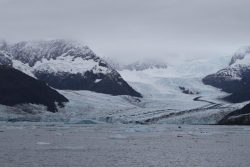
An oceanographer at the University of Washington is part of a new project to study how glacial particles, created as glaciers grind the rock beneath them into a powder, react with seawater to remove carbon dioxide from the atmosphere.
Alex Gagnon, an associate professor of oceanography at the UW, is one of the investigators on a newly funded project that involves field and lab studies of a natural setting that could help us understand the ocean’s role in carbon removal, which many experts believe will need to be combined with emissions reductions to address climate change.
ClimateWorks Foundation, a nonprofit based in San Francisco, and Ocean Visions, a research consortium, announced on Oct. 28 two 18-month grants to evaluate the environmental impacts of ocean-based carbon dioxide removal approaches through the study of natural environments.
Ocean-based carbon dioxide removal analogs are defined as natural marine settings that remove carbon dioxide from the atmosphere via processes that could theoretically be replicated, sped up or done at larger scales.
The team’s $220,000 grant will fund a study near the edge of glaciers that contact the ocean at high tides in Alaska’s Prince William Sound. Researchers will measure the rate of addition of alkaline material from rocks surrounding the fjords, where glaciers naturally pulverize rocks and discharge fine-grained particles into the ocean. The study will measure CO2 uptake at various water depths and in the sediments to test the link between adding alkaline powder and atmospheric CO2 removal. The team will also determine how trace metals released by the rocks, such as zinc and iron, affect marine ecosystems.
Read more at UW News »
